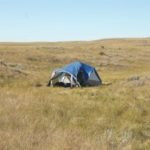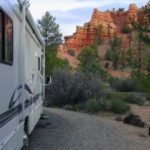Guidelines for Disperse camping
There are basically two types of camping in your national forests. You can camp in a developed campground or disperse camp outside developed campgrounds. One difference between the two is there is often a fee to camp in a campground and none if you disperse camp. Also when you disperse camp there are no facilities, such as toilets or treated drinking water, were as you have such in developed campgrounds.
Disperse camping provides outstanding camping opportunities. Long popular with tent and car campers, backpackers and “thru-hikers”, disperse camping is growing in popularity for “self-contained” campers. Here are some guidelines to use when planning a disperse camping adventures no matter the camping style.
Rules and Regulations –
Specific rules and regulations vary from one national forest to another so check with the forest you are going to enjoy. (Contact information is found at www.forestcamping.com.) Examples: backpackers in Superior National Forest’s wilderness areas may be required to view a “Leave No Trace” video and take a quiz to verify their knowledge; and, Angeles National Forest imposes seasonal restrictions on camping areas for migrating salamders.
Campsites –
Choose your campsite carefully. For privacy, select a secluded camp, screened from roads and other human activity. Two hundred feet separation and dense natural screening is considered ideal. Also establish a campsite’s size appropriate to your needs and, when through, return the area to its natural condition. Protect the environment by avoiding delicate meadows, streams, and river banks. Look for level ground a little higher than surround area and never “trench” around your tent. Also, always check with forest folks about any location restrictions and if a no-fee “permit” is required.
Fires –
A small campfire minimizes damage to the ground and conserves firewood. Use only Dead-and-Down wood. Do Not cut trees or branches from standing trees for fuel. They burn poorly and smoke. Leave all plants, shrubs, trees, and standing snags undisturbed to preserve a sense of naturalness. It is also suggested you bring an axe, shovel, and bucket to help manage your campfire. FYI – Camp stove, used for cooking, are preferred in most forests.
Pets –
If you bring a pet, keep it restrained out of respect for your camping neighbors and wildlife. Unsupervised pets are not encouraged within any National Forests. Unsupervised pets can have painful experiences with wildlife. Don’t forget to pick up after your pet.
Waste Disposal –
Dispose of all waste water and fish entails at least 100 feet from any water. Burn food waste or pack it out and remember aluminum foil does not burn. If camping in a recreational vehicle, haul your human waste to a sanitation dump – Do Not dump it in the forest. No an RVer? Dig a “cat hole”, a 6 to 8 inch deep hole, and bury “deposits” in it.
Trails and Roads –
Motorized vehicles should stay on designated roads and trails. Avoid wheel impacts to meadows, streams, and steam banks. Do not develop new trails or roads. Non-motorized campers should follow the same principles when using trails. Resist the urge to take shortcuts as it destroys vegetation and may cause erosion.
These are a pretty general guidelines but should give a feel for what you need to think about if your want to try this growing mode of camping.








